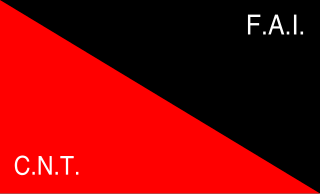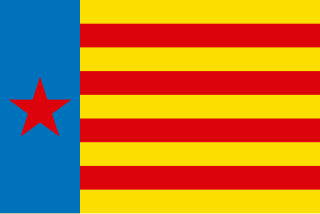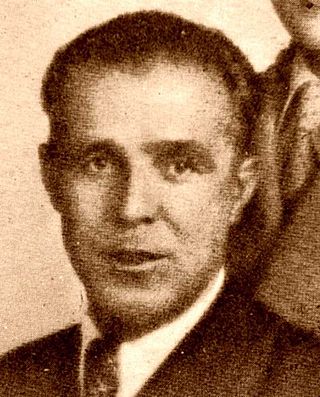
The Spanish Revolution was a workers' social revolution that began at the outbreak of the Spanish Civil War in 1936 and for two to three years resulted in the widespread implementation of anarchist and, more broadly, libertarian socialist organizational principles throughout various portions of the country, primarily Catalonia, Aragon, Andalusia, and parts of the Valencian Community. Much of the economy of Spain was put under worker control; in anarchist strongholds like Catalonia, the figure was as high as 75%. Factories were run through worker committees, and agrarian areas became collectivized and run as libertarian socialist communes. Many small businesses, such as hotels, barber shops, and restaurants, were also collectivized and managed by their workers.

The Iron Column was a Valencian anarchist militia column formed during the Spanish Civil War to fight against the military forces of the Nationalist Faction that had rebelled against the Second Spanish Republic.

The confederal militias were a movement of people's militia organized during the Spanish Civil War by the dominant organizations of anarchism in Spain: the National Confederation of Labor (CNT) and the Iberian Anarchist Federation (FAI).
The Harriers Column of the FAI, or Los Aguiluchos, was the last of the great Catalan anarcho-syndicalist columns. Later, more militias left Catalonia for the front, but they would no longer do so in the form of a column but rather as reinforcement units of the existing columns. This column was supposed to form a large unit - of around 10,000 combatants - but it ended up reinforcing the Ascaso Column as an autonomous column - with about 1,500 militiamen with 200 militiawomen. Organized in the Bakunin barracks in Barcelona, it was sent to the Huesca front on 28 August, with Juan García Oliver and Miguel García Vivancos leading the column.
The Iberia Column was a militia column that operated at the beginning of the Spanish Civil War.

The Popular Executive Committee of Valencia was a revolutionary autonomous entity created on July 22, to confront the Spanish coup of July 1936 which started the Spanish Civil War. It was made up of the political forces of the Popular Front and the trade union forces of the National Confederation of Labor and General Union of Workers. Based in Valencia, it covered most of Valencia province and part of Castellón and Alicante.

Gregorio Jover Cortés was an Aragonese anarcho-syndicalist and a member of the CNT during the first third of the 20th century. During the Spanish Civil War he was commander of the Ascaso Column and later the militarized 28th Division, which fought on the Aragon front.
The 25th Division was one of the divisions of the Spanish Republican Army that were organized during the Spanish Civil War on the basis of the Mixed Brigades. It participated in the battles of Huesca, Belchite, Teruel and Levante.
The 28th Division was one of the divisions of the Spanish Republican Army that were organized during the Spanish Civil War on the basis of the Mixed Brigades. It was deployed on the Aragon and Segre fronts.
The 83rd Mixed Brigade was a unit of the Spanish Republican Army created during the Spanish Civil War from the militarization of the Iron Column. It came to operate on the Teruel, Levante and Central fronts.
The 127th Mixed Brigade was a unit of the Spanish Republican Army, belonging to the 28th Division, created during the Spanish Civil War. It operated on the Aragón and Extremadura fronts.
The 81st Mixed Brigade was a unit of the Spanish Republican Army created during the Spanish Civil War. It operated on the Teruel, Levante and Estremadura fronts.
The 82nd Mixed Brigade was a unit of the Spanish Republican Army created during the Spanish Civil War. It came to operate on the Teruel and Levante fronts.
The 61st Mixed Brigade was a unit of the Spanish Republican Army that took part in the Spanish Civil War. Throughout the war, the brigade was present on the Teruel, Aragon, Levante and Extremadura fronts.
The 116th Mixed Brigade was a unit of the Spanish Republican Army, integrated into the 25th Division, that participated in the Spanish Civil War.
The 24th Division was one of the divisions of the Spanish Republican Army that were organized during the Spanish Civil War on the basis of mixed brigades. Throughout the war, the unit was deployed on the Andalusian, Madrid, Aragon and Segre fronts, taking part in some of the main battles.
The XVI Army Corps was a military formation of the Spanish Republican Army that fought in the Spanish Civil War. It had an outstanding performance in the Levante campaign.
The XIX Army Corps was a military formation of the People's Army of the Republic that fought during the Spanish Civil War. Located on the Teruel Front, it took part in the Teruel and Levante campaigns.
The 41st Division was one of the divisions of the People's Army of the Republic that were organized during the Spanish Civil War on the basis of the Mixed Brigades. It took part in the battles of Teruel, Alfambra and Levante.
The 95th Mixed Brigade was a unit of the Spanish Republican Army that took part in the Spanish Civil War. Throughout the war, various brigades came to use the number "95", operating on various fronts.




